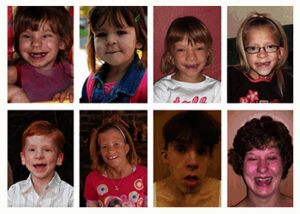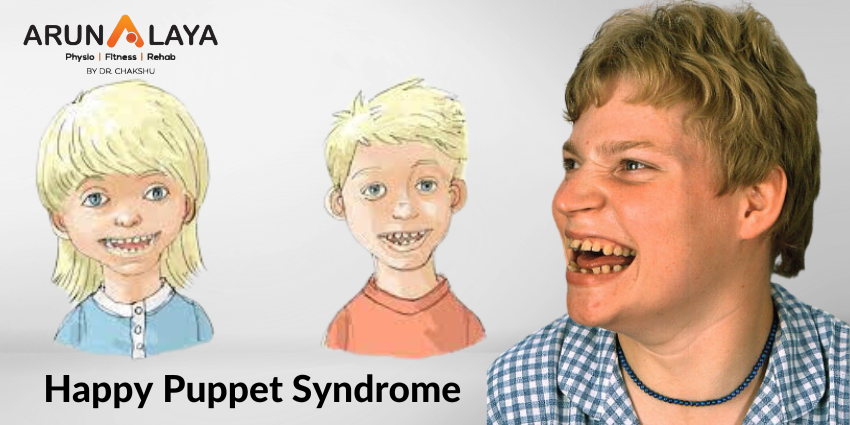Happy Puppet Syndrome
Introduction
Happy Puppet Syndrome is a rare and complex genetic disorder that primarily affects central nervous system characterized by severe learning difficulties, motor dysfunction, seizure disorder, and often a happy, sociable demeanour.
People with Happy puppet syndrome often smile and laugh frequently, and have happy, excitable personalities.
Happy puppet syndrome was first described in 1965 by British paediatrician Harry, who identified a group of children with similar symptoms that he termed “happy puppet syndrome.” The term “puppet” referred to the jerky movements and uncoordinated gait that are characteristic of the condition.
The initial indicators of happy puppet syndrome are usually developmental delays that appear between the ages of 6 and 12 months. Seizures might start between the ages of two and three.
The condition is causes by a genetic mutation or deletion on chromosome 15, which leads to deficiency of protein called ubiquitin ligase E3A (UBE3A). This protein is important for normal functioning of nerve cells in brain, and its absence or deficiency can result in the neurological symptoms of happy puppet syndrome.
The prevalence of happy puppet syndrome is estimated to be around 1 in 12,000 to 20,000 individuals, although it may be underdiagnosed or misdiagnosed. The condition can affect individuals of any race or ethnicity, and there is no known gender predilection.

SYMPTOMS
- Developmental delay and intellectual disability including no crawling or babbling at 6 to 12 months.
- Seizures, usually beginning between 2 and 3 years of age.
- Absence or minimal speech.
- Hyperactivity and excitability.
- Unsteady or jerky gait.
- Difficulty in balance.
- Sucking or feeding difficulty.
- Trouble going to sleep and staying asleep.
- Happy demeanour, frequent smiling and laughter, and an easily excitable personality.
- Stiff or jerky movements.
- Small head size, with flatness in the back of the head.
- Tongue thrusting.
- Hair, skin and eyes that are light in colour.
- Unusual behaviours, such as hand flapping and arms uplifted while walking.
- Curved spine (scoliosis).
Diagnosis
The diagnosis of happy puppet syndrome is usually made based on clinical signs and symptoms, along with genetic testing to confirm the deletion or mutation of the UBE3A gene on chromosome 15.
A diagnosis is based upon:
-
- a thorough clinical evaluation and identification of distinctive findings; and
- a full history of patients.
Genetic testing, such as DNA methylation, must be conducted in order to confirm a suspected diagnosis. These tests may review:
-
- Parental DNA pattern: screens for three of the four known genetic defects that cause happy puppet syndrome.
- Missing chromosomes: A chromosomal microarray (CMA) can detect missing chromosomes.
- Gene mutation: If your child’s DNA methylation test findings are normal, your doctor may request a UBE3A gene sequencing test to look for a maternal mutation.
Differential Diagnosis
- Prader-willi syndrome
- Rett syndrome
- Mowat wilson syndrome
- Pitt-hopkins syndrome
TREATMENT
The treatment for happy puppet syndrome is primarily supportive and focuses on addressing specific symptoms, such as seizures, sleep disorders, and behavioral problems. Early intervention with physical, occupational, and speech therapy is important to improve mobility, communication, and social skills. Educational support and specialized services may also be required to help individuals with the syndrome reach their full potential.
PHYSIOTHERAPY MANAGEMENT
Physiotherapy is an important part of the multidisciplinary approach to managing happy puppet syndrome.
The goals of physiotherapy are to improve movement, balance, and coordination, prevent joint contractures and deformities, and enhance overall physical function.
The physiotherapy treatment typically includes:
- Assessment: The physiotherapist will perform a comprehensive assessment of the individual’s physical abilities. It will include range of motion, strength, balance, and gait analysis.
- Treatment plan: Based on the assessment results, the physiotherapist will develop an individualized treatment plan that addresses the specific needs of the individual.
- Exercises: The physiotherapist will prescribe exercises to improve muscle strength, flexibility, and balance. Exercises may include stretching, strengthening, and balance training exercises.
- Assistive devices: The physiotherapist may recommend the use of assistive devices such as walkers, orthotics, or braces to help improve mobility and prevent falls.
- Hydrotherapy: Water-based exercises can be particularly beneficial for individuals with happy puppet syndrome. The buoyancy of the water can reduce the risk of injury while allowing for a full range of motion.
- Functional training: The physiotherapist will work with the individual to improve their ability to perform daily activities, such as sitting, standing, and walking.
- Education: The physiotherapist will educate the individual and their caregivers on safe movement techniques, fall prevention, and the importance of ongoing exercise and physical activity.

